Kitesurfing in the Algarve: Your Complete Guide
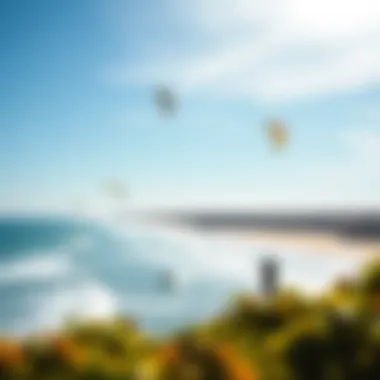
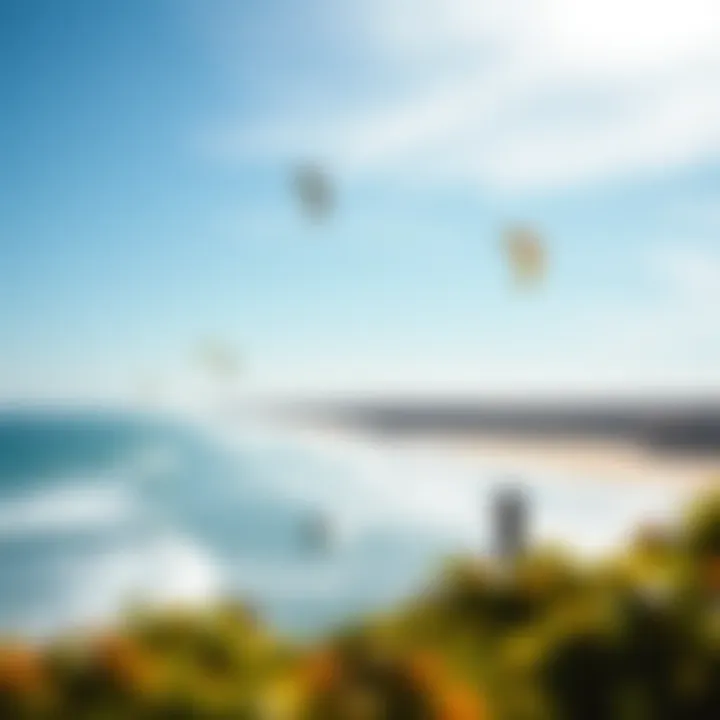
Intro
Kitesurfing in the Algarve is not just a sport; it's an experience that intertwines adrenaline with breathtaking coastal beauty. For many kiteboarders, the Algarve is a second home, drawing both novices and seasoned pros alike with its mix of stunning beaches, favorable winds, and welcoming surf communities.
This guide aims to serve as your roadmap through the captivating world of kitesurfing in this remarkable region of Portugal. From understanding the ideal weather conditions that power your ride to uncovering the essential gear, this narrative brings forth a wealth of information dressed in engaging insights.
It’s not simply about catching the wind; it’s about the journey—navigating through the vibrant kitesurfing culture, understanding safety practices, and savoring the thrill that only kitesurfing can offer. Whether you're just starting or looking to sharpen advanced techniques, there’s something here for everyone, ready to enhance your experience in the Algarve.
Equipment Insights
When diving into kitesurfing, having the right gear can make all the difference. The proper equipment doesn’t just enhance your performance but also plays a pivotal role in keeping you safe on the water.
Latest Gear Reviews
Among the wide variety of kitesurfing gear options, two brands stand out—North Kiteboarding and Cabrinha.
North Kiteboarding's SLE Kites have garnered praise for their stability and ease of control, making them a top choice among beginners. The lightness of the kite brings an incredible feeling of freedom, allowing riders to enjoy an uninterrupted cruising experience.
Cabrinha’s Switchblade, on the other hand, is often regarded as the go-to choice for advanced riders looking to push their limits. Its versatility allows it to excel in a range of conditions, making it a reliable partner whether you’re carving sharp turns or launching impressive tricks.
But it’s not just about the kites. Bindings like the ION Element offer excellent comfort and support, whereas a great board would be the Slingshot Misfit, known for its speed and pop that help elevate your kitesurfing experience.
Essential Gear Maintenance
Caring for your kitesurfing gear ensures longevity and peak performance. Here are some vital maintenance tips:
- Clean Your Gear: Rinse your kite and board in fresh water after each session to remove salt and sand.
- Check for Damage: Regularly inspect your lines and fabric for any wear or tear.
- Store Properly: Keep your gear in a cool, dry place, away from direct sunlight to avoid material degradation.
“Taking care of your equipment leaves you free to focus on what really matters: enjoying the ride.”
When you're out in the water, there's a certain joy in knowing you’ve taken steps to keep everything in mint condition.
Technique Exploration
Mastering kitesurfing isn't solely about the equipment; it's also about honing your skills on the water.
Beginner Techniques
For anyone just getting started, stance and balance are crucial. Begin with staying low to maintain stability. The right stance helps you control the kite and board better. Consider these basic moves:
- Edge Control: Learning how to edge your board against the pull of the kite is essential for maintaining speed.
- Kite Handling: Practice flying your kite on land before hitting the water. Understanding how to steer effectively makes all the difference.
Advanced Maneuvers
For those who have got the hang of the basics and are eager to advance, try your hand at tricks like the jump and the backroll. Mastery of these moves takes time, but here’s a simple breakdown on how to go about it:
- Jump: Start by building speed and edging hard against the pull of the kite.
- Backroll: As you jump, initiate a spin by looking over your shoulder, pulling on your back hand while keeping your weight centered over the board.
Your journey toward becoming a skilled kiteboarder can seem intricate, but each small step contributes to the larger picture.
As you immerse yourself into kitesurfing, keep in mind the intricate dance between your body, the kite, and the elements. It’s a blend of skill, technique, and joy that truly encapsulates the spirit of this thrilling sport.
Prologue to Kitesurfing in the Algarve
Kitesurfing has gained considerable traction around the globe, and the Algarve stands out as a prominent locale for this exhilarating sport. Nestled on Portugal's southern coast, the region boasts diverse landscapes and dynamic wind patterns, making it a favorite playground for both seasoned riders and those just dipping their toes into the sport. But what sets kitesurfing in the Algarve apart from other destinations?
This article unpacks the intricacies of kitesurfing here, shedding light on the unique geographical elements, weather quirks, and cultural aspects that enhance the kitesurfing experience. Why focus on this specific region? The Algarve is more than just scenic views; it’s a kitesurfing haven offering something for everyone, from flat waters ideal for beginners to challenging waves that entice advanced boarders.
Key Elements to Consider:
- Variety in Locations: Whether it’s wide open spaces perfect for beginners or tougher setups for experts, the Algarve's numerous beaches cater to different skill levels and preferences.
- Favorable Winds: The wind conditions in this part of Portugal are often optimal for kitesurfing, providing consistency that enthusiasts crave.
- Cultural Richness: The local community embraces kitesurfing, with numerous events fostering camaraderie among participants. Engaging with fellow kiteboarders adds another layer of enjoyment.
The importance of understanding kitesurfing in the Algarve can't be understated; it’s not just about riding the waves. The vast array of conditions, coupled with the warm Mediterranean climate, creates an inviting environment that captures the imagination of riders. There’s a certain thrill of gliding through crystal blue waters against a backdrop of dramatic cliffs and golden sands that one can't find anywhere else.
Ultimately, as we journey through this guide, we’ll delve into specific locations, essential gear, safety practices, and much more—ensuring that both novices and veteran riders alike can make the most out of their experience in this glorious playground. Exploring these dimensions in depth will not only prepare you for your next adventure but will also enhance the appreciation of kitesurfing as a discipline and a lifestyle in the Algarve.
Geographical Features of the Algarve
The Algarve is a stunning region in southern Portugal, well-regarded not just for its picturesque coastlines but also for the geographical features that make it a kitesurfing paradise. Understanding these features lays the groundwork for successful and exhilarating kitesurfing experiences. The blend of natural beauty, wind patterns, and water conditions creates an ideal environment that both novices and experienced kiteboarders cherish.
Coastal Landscape
The coastline of the Algarve stretches around 200 kilometers, with dramatic cliffs, hidden caves, and sandy beaches. Each stretch has its own character; for instance, the beaches around Lagos pamper visitors with their soft, golden sands contrasted against the rugged cliffs. Exploring this diverse coastal landscape is essential for kitesurfers. The unique topography not only enhances the visual appeal but also influences the type of conditions encountered at various spots.
Moreover, specific beaches like Praia do Amado and Praia da Rocha are well-known among kitesurfers for their favorable wind directions and consistent waves. A deeper understanding of the topography allows kitesurfers to choose locations that suit their skill levels.
Did you know? The Algarve’s coastline is a combination of rocky formations and expansive beaches, meaning kitesurfers can often find sheltered spots away from stronger winds while still enjoying fantastic sessions.
Wind Patterns and Currents
Wind is the lifeblood of kitesurfing, and the Algarve does not disappoint. Characterized by reliable north-westerly winds known as the Alisios, the region provides outstanding conditions from spring to early autumn. These winds are typically steady, averaging around 12 to 25 knots, creating the perfect playground for kite enthusiasts.
The currents in the Algarve play a significant role too. Understanding local tidal patterns is key to successful kitesurfing. Some areas can have strong currents that could be daunting for inexperienced kiteboarders. Hence, it's paramount to keep track of tide tables and be aware of any sudden changes in water flow.
Important Insight: Always check local forecasts and conditions. The wind strength and direction can shift quickly, impacting your kitesurfing plans.
Weather Conditions Throughout the Year
Weather in the Algarve is generally mild and pleasant, contributing to its reputation as a year-round kitesurfing haven. Summer months tend to have warmer temperatures, averaging 25-30 degrees Celsius, making long kitesurfing sessions a delight. However, it’s essential to factor in the prevailing winds and their influence on sea conditions.
During winter, although temperatures can drop to around 15 degrees Celsius, the windy days are still quite frequent, allowing hearty kitesurfers to enjoy their passion outside the typical beach season. This variability attracts different types of riders, from summer sun seekers to winter adventurers.
In summary, the Algarve's geographical features create a distinctive and engaging environment for kitesurfing. Those who wish to explore these waters will benefit from understanding the coastal landscape, wind patterns, and year-round weather conditions to optimize their experiences.
Popular Kitesurfing Locations in the Algarve
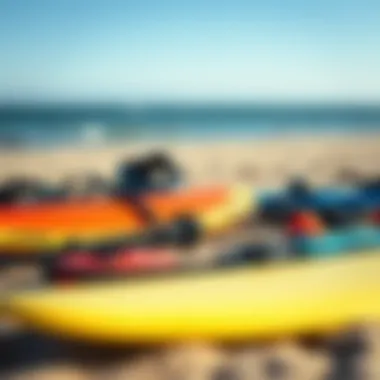
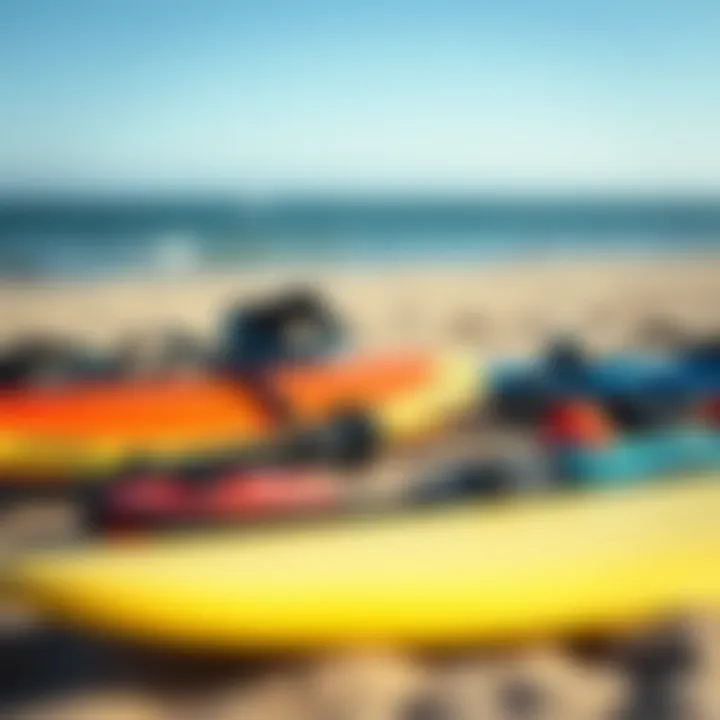
Kitesurfing in the Algarve offers a smorgasbord of ideal locations, each with its own allure and characteristics. Understanding these spots is crucial for kiteboarders, both newbies and veterans, as it allows them to find the right conditions for their skill level and preferences. Certain locales stand out due to their consistent winds, scenic beauty, and welcoming communities. A surf buddy or a professional instructor can make all the difference when choosing the best place for your kite sport endeavours, ensuring that anyone can propel themselves into the thrill of kitesurfing.
Lagos: A Coastal Jewel
Lagos stands out as a hotspot for kitesurfers thanks to its stunning coastal views and reliable wind conditions. The beaches here, like Praia de Batata, have a laid-back vibe that welcomes both beginners and seasoned riders. The consistent trade winds, particularly in the summer months, make it a prime location. There’s a sense of community among the kiteboarders, which often leads to shared tips, side chats about the waves, and even friendly competitions.
Key Features:
- Consistent Winds: Typically, the winds blow between 15-25 knots, offering ample opportunities for kiting throughout the day.
- Facilities: Numerous schools and shops provide gear for hire and lessons.
- Accessibility: Outfitters are located near the popular beaches, adding convenience for travelers.
Alvor: Ideal for Beginners
For those just dipping their toes in the kitesurfing waters, Alvor presents an ideal setting. Its calm beach and shallow waters make it easier for newcomers to learn the ropes without feeling overwhelmed. Instructors here are well-versed in guiding novices, instilling the necessary skills and confidence.
Highlighted Aspects:
- Shallow Waters: Perfect for practice and getting comfortable with the gear.
- Training Schools: Several reputable kitesurfing schools operate in Alvor, focusing on key techniques like body dragging and water starts.
- Gentle Winds: Generally lighter winds make the learning experience more enjoyable.
Vila do Bispo: Advanced Challenges
Vila do Bispo caters to more experienced kiteboarders who seek a challenge. The winds can be strong and unpredictable, offering a different riding experience compared to more user-friendly locations like Lagos and Alvor. Big waves and less crowded beaches can create some adrenaline-pumping sessions for those who thrive on pushing their limits.
Considerations for Kiteboarders:
- Skill Level Requirement: Not recommended for beginners due to challenging conditions.
- Dynamic Environment: Kiteboarders can experience variable wind patterns that require sharp reflexes and decisions.
- Natural Beauty: The rugged coastline offers breathtaking backdrops, enhancing the thrill of riding.
Tavira: A Hidden Gem
Tavira is somewhat tucked away, often flying under the radar compared to its more popular counterparts. Those who take the time to explore this charming town will discover pristine beaches and less trafficked waters. This location offers unique wind conditions that sometimes surprise even local riders. The friendly atmosphere lends itself well to those seeking a more personal kitesurfing experience.
Attractive Features:
- Less Crowded: Enjoy the tranquility of catching waves without a throng of people around.
- Local Culture: Experience the Algarve's rich cultural backdrop while enjoying modern kitesurfing facilities.
- Gorgeous Landscape: Take advantage of stunning views while you kite, perfect for some post-session relaxation.
"Choosing the right location for kitesurfing can redefine your experience, helping you grow and absolutely have fun while riding the waves."
Overall, the Algarve region is infused with opportunities for kitesurfers of various skills. Grasping the distinct features of each location elevates the potential for a memorable kitesurfing adventure.
Ideal Conditions for Kitesurfing
Kitesurfing is a dance of nature, and its grace is directly influenced by the conditions on the water. Understanding the ideal conditions for kitesurfing not only enhances your experience but also ensures safety. This section delves into the key elements that create the perfect setting for both novice and seasoned kiteboarders. Knowing about wind patterns, tidal effects, and water conditions can turn an average outing into a spectacular adventure on the waves.
Wind Speed and Direction
Wind is the heartbeat of kitesurfing. It’s what fills your kite and lifts you above the water. In the Algarve, typical wind speeds of 12 to 25 knots during the summer months create an exhilarating environment for kite enthusiasts.
- Ideal Wind Speed: For beginners, a gentle breeze of around 12 to 15 knots is often perfect. It’s enough to lift your kite but not so strong that it becomes unmanageable. Advanced riders, however, often seek gusts up to 25 knots to practice tricks and experience high-speed rides.
- Wind Direction: It's crucial to pay attention to wind direction. Cross-shore winds—those that blow perpendicular to the coast—are generally safest. They allow for a better starting point and a less risky return to shore. On the other hand, onshore winds can lead to dangerous situations as they may push kiters toward the beach.
"Knowing the wind is as important as mastering the kite. It's the silent pulse guiding your every move on the water."
Tidal Effects on Kitesurfing
Tides can significantly alter kitesurfing conditions in the Algarve. Understanding how tides work can help riders optimize their timing and location.
- Effect of Tides: During high tide, certain beaches offer less riding space as the water raises higher along the shore. Conversely, during low tide, kiteboarders often find flat water—ideal for beginners and trick practice.
- Timing Your Session: Check local tide schedules before heading out. Tools like tide charts can help you predict when conditions will be favorable. In the Algarve, some beaches have better conditions during particular tidal phases.
Water Conditions: Waves versus Flat Water
The type of water conditions greatly influences the riding style of kitesurfers. In the Algarve, you can find both waves and flat waters, each catering to different preferences and skill levels.
- Waves: For those seeking thrill, the wave conditions provide a thrilling environment. The south coast is renowned for its surf, offering waves that can range from gentle swells to challenging formations, appealing to adrenaline junkies.
- Flat Water: In contrast, lagoons such as those found in Alvor and Tavira present smooth, glass-like surfaces. These conditions allow for easy learning and are perfect for practicing jumps and tricks without the distraction of breaking waves.
Ultimately, your choice between waves and flat water can enhance or curb your riding experience. Recognizing your skill level and comfort with each environment will go a long way.
In summary, understanding the elements surrounding wind speed and direction, tidal cycles, and water conditions will bolster your kitesurfing adventures in the Algarve. These insights don’t just make you a better kiter; they deepen your connection to the natural elements that define the sport.
Essential Kitesurfing Gear
When engaging in kitesurfing, having the right gear is not just a matter of comfort but a critical factor in safety and performance. The complexity of this sport means that each element of your setup plays a significant role. Without proper equipment, the exhilarating thrill of kitesurfing can quickly turn sour, especially for beginners, but even seasoned riders need to think ahead about their gear to tackle new challenges or conditions.
Kites: Types and Sizes
Kites are the heart of kitesurfing. They come in various types and sizes, each serving a distinct purpose based on wind conditions and rider experience. Generally, kites are categorized into types like inflatable kites, which are ideal for beginners due to their stability, and foil kites, better suited for experienced riders looking to ride in lighter winds.
- Inflatable Kites: These have a frame that holds the shape when inflated, offering great lift and stability. They’re forgiving during maneuvering and provide a smoother experience for newcomers.
- Foil Kites: These kites are used when wind conditions are not optimal for inflatable types. They can catch wind from both sides and tend to be more efficient.
When selecting a kite size, consider factors like your weight, local wind conditions, and skill level. For example, larger kites (over 12m) will catch more wind, making them suitable for lighter wind conditions, however, they may also be harder to control for beginners. Conversely, smaller kites (7m–9m) are easier to maneuver but require stronger winds. Thus, understanding your specific needs is crucial.
Boards: Choosing the Right One
Your board is your lifeline on the water, and choosing the right one can make all the difference. Just like kites, boards come in various shapes and sizes:
- Twin-Tip Boards: These are the most common. They allow you to ride in both directions and are favored for tricks and freestyle riding. They are versatile and often suited for all levels.
- Directional Boards: For those looking to explore waves or surf styles, directional boards are recommended. They excel at stability and speed, providing a unique experience compared to twin-tips.
When selecting a board, think about your riding style and the conditions you'll encounter. A beginner might do well with a larger, more stable board, while someone looking to pull off tricks may prefer a smaller, lighter model. Moreover, fin configurations can also influence performance; more fins for stability, fewer for speed and maneuverability. Finding a board that complements your kite is equally important, ensuring harmony in performance for a seamless riding experience.
Safety Equipment: Harnesses and Helmets
Safety cannot be overstated in kitesurfing. The thrill of cutting through waves comes with inherent risks. Thus, proper safety equipment is non-negotiable. Your harness and helmet are two of the most vital components, often overlooked by newcomers.
- Harnesses: These come in two main types - seat harnesses and waist harnesses. Seat harnesses are more secure for beginners as they distribute pressure evenly across the body, making it easier to maintain balance. In contrast, waist harnesses allow for more freedom of movement and are popular among experienced riders who perform tricks. Choosing the correct fit is essential; a snug fit allows for maximum control.
- Helmets: Head injuries can happen in kitesurfing, especially during a fall or collision. Wearing a helmet designed specifically for water sports can protect against impacts. Look for helmets that are lightweight, well-ventilated, and with a secure fit. It’s a wise investment for long-term safety, regardless of expertise.
"In kitesurfing, your gear is your safety net; neglected gear can lead to far more than just a bad day on the water."
For more detailed advice on gear, you might find resources like Wikipedia or recent discussions on Reddit useful.
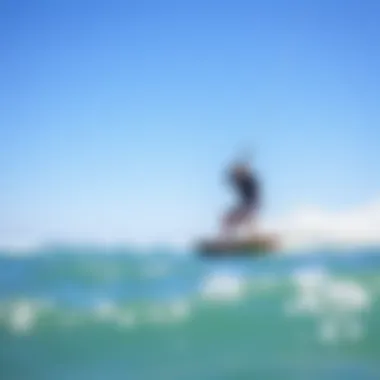
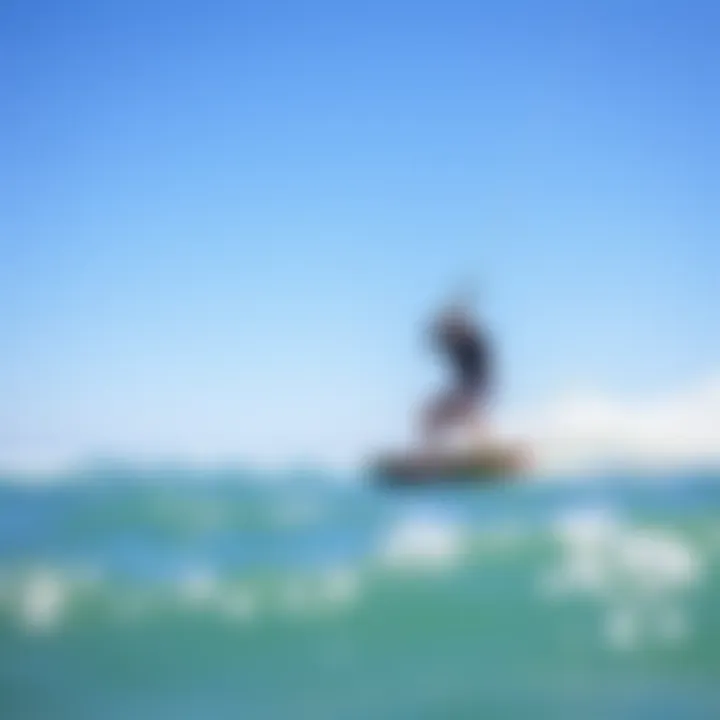
Safety Practices for Kitesurfing
Safety is paramount in kitesurfing, especially when navigating the waves and winds of the Algarve. Ensuring that you follow rigorous safety practices not only safeguards your wellbeing but also enhances your overall experience on the water. Understanding the dynamics of your environment, knowing emergency protocols, and recognizing your own limits are all integral parts of enjoying this exhilarating sport.
Understanding and Assessing Risks
Before you step onto the water, it's crucial to assess the risks involved in kitesurfing. The Algarve might boasts splendid landscapes and ideal wind conditions, but it's not without its hazards. To start off, storms can roll in quickly, changing conditions in a heartbeat.
Some key factors to consider include:
- Wind Speed: Check local wind forecasts. High winds can be dangerous, particularly for less experienced riders.
- Water Conditions: Be aware of currents, tides, and local marine traffic. These can significantly influence your safety.
- Obstructions and Local Wildlife: Rocks, reefs, and marine life like jellyfish can pose hazards. Familiarize yourself with the area before riding.
A good approach is to keep an eye on other kitesurfers. If you see them struggling or returning to shore, it might be time to rethink your session.
Emergency Procedures
Accidents can happen—this is true in any sport. However, having a clear understanding of emergency procedures can be a game changer. Here’s what to keep in mind:
- Know How to Signal for Help: Whether it’s using your kite to signal distress or a whistle, make sure these tools are easily accessible.
- Self-Rescue Techniques: Familiarize yourself with self-rescue methods, such as using your board as a flotation device. Understanding how to inflate your kite and let it drift can also come in handy if you find yourself in a sticky situation.
- First Aid Training: Consider taking a first aid course. Knowing how to handle minor injuries could make a difference if mishaps occur.
"Preparation is the key to a safe kitesurfing experience. The more you know, the less you need to worry."
Having a plan in place gives you the confidence to enjoy your sessions without constantly worrying about potential dangers.
Staying Within Limits: Skill and Experience
One of the hardest lessons for beginner and intermediate kitesurfers is recognizing one’s own limitations. The Algarve’s stunning beaches might tempt you to push beyond your capabilities. However, doing so could lead to dangerous situations.
Here are some pointers on how to stay within your own limits:
- Practice in Controlled Conditions: Start in lighter winds and shallower waters where you can gain confidence without overstretching your abilities.
- Join a Local School or Club: Learning from experienced instructors provides invaluable insights and builds your skills in a safe environment.
- Progress Gradually: Aim to master fundamental techniques before moving on to advanced tricks or conditions. There’s no rush; kitesurfing is for enjoyment!
Remember, everyone started somewhere. Building your skill set is like stacking blocks; each level needs a solid foundation to reach new heights.
In summary, taking safety seriously in kitesurfing is not just about rules—it's about being responsible. By understanding risks, preparing for emergencies, and knowing your limits, you guarantee not only your own safety but also contribute to a safer environment for fellow riders.
The Learning Curve: Tips for Beginners
Kitesurfing, while exhilarating, can be a daunting venture for newcomers. Mastering the art of harnessing wind and water requires more than just enthusiasm; it demands knowledge, practice, and the right guidance. This section is dedicated to easing beginners into the world of kitesurfing, focusing on essential tips that set the stage for a safe and enjoyable experience. By understanding these key aspects—like finding the right instructor, mastering fundamental techniques, and building confidence in the water—novice kiteboarders can navigate their journey effectively.
Finding the Right Instructor
The first and perhaps the most crucial step towards becoming a proficient kitesurfer is to seek out a qualified instructor. A well-trained professional can provide invaluable insights. They not only teach the basics of operating a kite, but they can also share situational awareness that is beyond the pages of a manual. It’s important to look for instructors who are certified and have substantial experience in kitesurfing. A good instructor will tailor lessons to meet your individual needs and skills. Moreover, some considerations to keep in mind while searching include:
- Reputation: Reviews and testimonials from former students can shed light on the instructor’s effectiveness. Websites like Reddit or specialized kitesurfing forums often present honest feedback.
- Personality Matching: Teaching styles can vary widely. Finding an instructor whose teaching approach resonates with you can enhance the learning experience.
- Safety Record: Instructors should prioritize the safety of their students. Ensure that they provide safety gear and teach essential safety protocols.
Fundamental Techniques to Master
Once you’ve secured a good instructor, the next focus should be the fundamental techniques essential for kitesurfing. The learning process encompasses both theoretical knowledge and practical skills. Some fundamental techniques to master include:
- Kite Control: Understanding how to pilot the kite is paramount. Learning how it interacts with the wind and how to adjust your flying style is essential.
- Body Dragging: This technique helps in getting accustomed to the water and understanding how to maneuver with the kite while in the water. It’s invaluable in developing coordination.
- Water Starts: The transition from being in the water to riding on the board is often challenging. Practicing this under the guidance of an instructor will facilitate faster learning.
- Board Handling: Correctly positioning and managing the board while kite surfing are essential skills that require practice.
With focused practice on these techniques, beginners can build a strong foundation that will serve them well in advanced kiting skills.
Building Confidence in the Water
Ultimately, confidence plays a pivotal role in a kitesurfer's journey. It’s not just about skill; it’s about feeling comfortable and secure in the water. Here are some strategies to bolster your confidence:
- Start Small: Begin with gentle winds and shallow waters. This lessens the intimidation factor and allows you to focus solely on mastering the basics.
- Practice Regularly: The more time spent on the water translates to more familiarity and comfort level. Consistency goes a long way in building confidence.
- Join Group Sessions: Learning alongside others can create a supportive environment. Watching peers tackle similar challenges can also reinforce your belief in your capabilities.
"It’s not the size of the kite or the best gear you have; it’s how comfortable you are with what you’ve got."
By addressing these areas, beginners can approach kitesurfing in the Algarve not just as a thrilling experience, but as a gradual learning curve that culminates in mastery over time. As you embrace the challenges, remember that persistence and patience are your truest allies in the wind and surf.
Kitesurfing Community and Culture
Kitesurfing is not merely a sport; it's a way of life for many who embrace the wind, sea, and the thrill of gliding over water. In the Algarve, this vibrant community pulses with excitement, bonding over shared experiences and mutual love for the sport. The culture surrounding kitesurfing here offers a rich tapestry of interpersonal connections, collective learning, and shared appreciation for nature’s beauty.
Local Events and Competitions
In the Algarve, the kitesurfing calendar is full of events that attract enthusiasts from all around. From local competitions to international championships, these gatherings are more than just opportunities to showcase skills. They serve as a platform for camaraderie, where seasoned riders can share tips and novices can soak up wisdom. Popular events, such as the Algarve Kite Weekend, often include workshops, demos, and social mixers that enrich the community spirit.
Attending local competitions offers an inside look into advanced techniques and maneuvers, inspiring newcomers and igniting friendly rivalries. Plus, these encounters often lead to lasting friendships and a network of kitesurfing comrades.
Connecting with Other Enthusiasts
Networking is an essential part of kitesurfing culture. Whether you're a veteran or a beginner, connecting with other enthusiasts can significantly enhance your experience. There are countless forums and social media groups dedicated to kitesurfing, where individuals share insights, tips, and even arrange meet-ups.
- Face-to-Face Meetings: Local schools often host group sessions, which allow you to meet fellow kitesurfers. Joining these sessions can provide crucial opportunities for learning and swapping experiences.
- Down at the Beach: Engaging with others directly at popular spots like Praia de Alvor or Lagos, helps build a community. Riding together not only improves skills but fosters a sense of belonging—a feeling that you’re part of something bigger than yourself.
The Role of Social Media in Kitesurfing
In this digital age, social media plays a pivotal role in shaping the kitesurfing community. Platforms like Instagram and Facebook serve as visual diaries where enthusiasts showcase their rides, share tutorials, and document travels. This wealthy platform empowers riders to connect irrespective of geographical boundaries.
Content on these platforms also influences brand promotions, enabling lesser-known kitesurfing gear to gain visibility. Additionally, hashtags such as #KitesurfAlgarve drive more traffic to potential spots and events, making it easier for newcomers to find their footing in the sport. With the click of a button, individuals can mobilize groups for trips and participate in challenges that keep spirits buoyant.
"Community bonds are often formed amid the waves and the sun. The adventures shared on the water transcend the sport itself."
Participating in these virtual communities can enrich your learning experience and keep you informed about the latest trends. From watching tutorials to engaging with experts, social media is a treasure trove of information that continues to shape the culture of kitesurfing in the Algarve.
Ultimately, the kitesurfing community in the Algarve strikes an exemplary balance between competition and collaboration, fostering an environment where everyone, regardless of skill level, can feel welcomed and inspired.
Environmental Considerations
Kitesurfing, while exhilarating and a means of connecting with nature, also carries the weighty responsibility of understanding its environmental impact. Acknowledging and addressing these effects is vital not just for the enjoyment of today's kiteboarders but for the preservation of the Algarve's stunning landscape and marine ecosystems for future generations. As enthusiasts, it’s our duty to foster sustainable practices and adopt a mindful approach to kitesurfing.
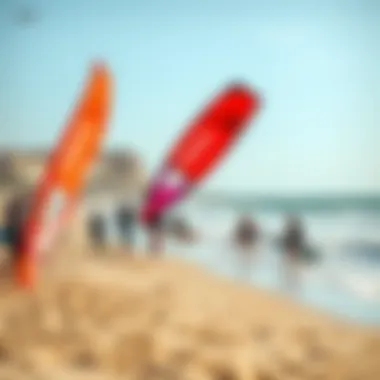
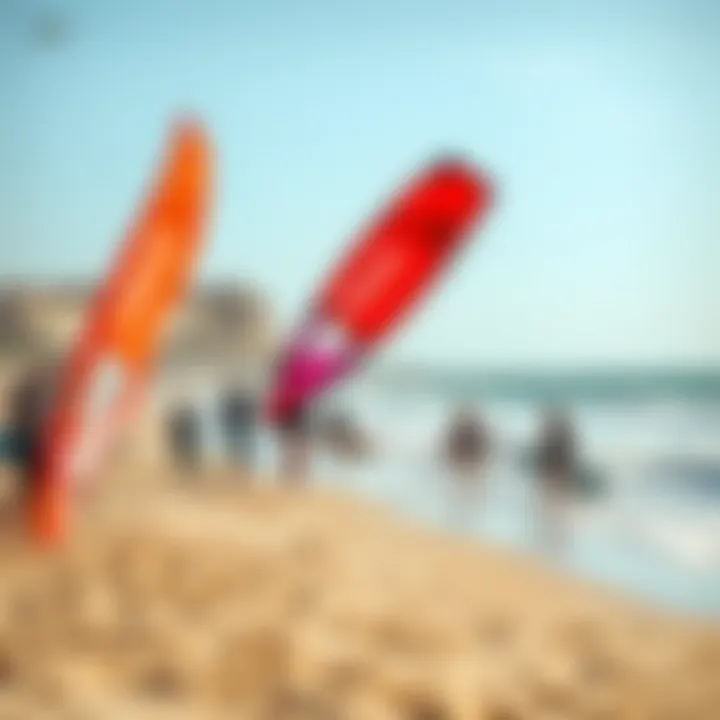
Sustainable Practices in Kitesurfing
Implementing sustainable practices in kitesurfing doesn’t require a radical overhaul, but rather a commitment to making small yet significant changes. Here’s a closer look at how kitesurfers can tread lightly on the planet, ensuring that both wind and water remain as vibrant as they are today.
- Gear Maintenance: Properly maintaining your equipment can greatly extend its lifespan. Regular checks and repairs not only save money but prevent unnecessary waste.
- Eco-Friendly Gear Options: As the market evolves, kite brands are increasingly offering eco-friendly materials. Opting for kites made from recyclable materials reduces our carbon footprint.
- Dispose Responsibly: When your gear reaches the end of its life, do not simply toss it in the bin. Seek out recycling programs or initiatives that promote upcycling of old kites and boards.
By taking these steps, kitesurfers can significantly lessen their ecological footprint, preserving the beauty of the Algarve while enjoying this thrilling sport.
Impact on Marine Life
One cannot overlook the delicate balance that exists in marine ecosystems, which can be disrupted by kitesurfing activities. With an increasing number of enthusiasts flocking to the Algarve’s dazzling shores, awareness around marine life must come to the forefront.
- Disturbances to Wildlife: Kitesurfing can inadvertently disrupt local wildlife, especially during mating seasons or in regions where endangered species reside. The noise and presence of kiteboarders can scare marine animals, affecting their behavior and habitat.
- Pollution Concerns: The use of certain sunscreens and oils can contribute to water pollution, further endangering marine life. It’s wise to choose biodegradable products when spending extended periods on the water.
Understanding these impacts informs kitesurfers on how they can enjoy their sport without compromising the natural environment.
Conservation Efforts in the Algarve
The Algarve is not just a playground for water sports enthusiasts; it’s also a crucial habitat for various species and ecosystems that need our protection. Conservation efforts are underway to mitigate the impact of recreational activities, including kitesurfing.
- Local Initiatives: Organizations often organize beach clean-ups and awareness campaigns. Joining these efforts not only supports the environment but connects you with fellow kiteboarders who share similar values.
- Protected Areas: Some regions within the Algarve are designated as protected areas where kitesurfing activities may be restricted to minimize human impact. Respecting these boundaries is key to ensuring the longevity of the environment.
- Education Programs: Promoting education around sustainable kitesurfing practices fosters a sense of responsibility within the community. Workshops and seminars hosted by local surf schools can equip riders with essential knowledge on the local ecosystems.
As kitesurfers, we hold the power to maintain the balance between adventure and stewardship. It's about creating waves of change, where our passion for kitesurfing coexists harmoniously with the natural world.
Advanced Techniques for Experienced Riders
Kitesurfing is more than just a pastime; it's a thrilling combination of skill, technique, and artistry that has seen enthusiasts push boundaries and redefine potential. For those who have mastered the basics, exploring advanced techniques can elevate one’s game to new heights. Whether you’re trying to perfect a graceful jump or engage in complex maneuvers, understanding these advanced techniques is crucial for both performance and safety.
Unlike beginners, experienced riders have the advantage of a strong foundation, making it easier to delve into tricks and maneuvers that leave onlookers in awe. Moreover, mastering advanced techniques not only enhances riding style but also allows kiteboarders to respond better to varying conditions and challenges on the water, expanding their ability to navigate different environments effectively.
Tricks and Maneuvers
The world of kitesurfing is brimming with tricks that can impress and invigorate any session. Some of the popular tricks you should consider are:
- Jumping: This involves getting airborne off a wave or chop, combining strength and finesse. It's crucial to release your kite at the peak of the jump for better airtime.
- Backrolls: A tricky move where the rider rotates backward in the air. Timing and kite position play a vital role in executing this maneuver successfully.
- Handlepasses: Requiring a unique level of control, this trick involves passing the control bar behind the body while midair. It enhances technical skills and adds flair to your performance.
Getting these tricks right demands practice and an understanding of load and pop dynamics. Watching videos of experienced riders can offer insight into the body movements and kite control essential for proficiency. Tip: Always practice in safe locations and ideally with the guidance of an instructor who specializes in advanced techniques.
Enhancing Performance with Equipment
For advanced riders, equipment plays a pivotal role in performance. Choosing the right gear can significantly impact your surfing experience. Here are some aspects to consider:
- Kite Selection: Opt for a size that suits your weight and style. A lighter rider may find a smaller kite more manageable, while heavier riders may benefit from a larger kite.
- Board Choice: Different board designs cater to various styles. A freestyle board typically has a flat base for tricks, while a directional board suits wave riding better.
- Lines and Harnesses: Updating lines to a lighter and more durable material can also enhance handling. A well-fitted harness provides comfort, allowing longer sessions without fatigue.
Invest in quality gear; the right equipment not only helps in executing tricks but also boosts overall performance and enjoyment on the water. Research reputable brands and read reviews to make informed decisions.
Competing at Higher Levels
With skill comes ambition. Those who aim to compete should understand that competing at higher levels requires more than just practice; it involves strategy, mindset, and preparation.
When preparing for competitions, consider the following:
- Regular Training: Consistency trumps perfection. Develop a solid training schedule that includes strength and conditioning to enhance stamina and responsiveness.
- Understand Competition Format: Familiarize yourself with the specific rules of the competitions you’ll participate in. Different events may emphasize various aspects, such as freestyle or wave riding.
- Mental Preparedness: Competing can be nerve-wracking. Techniques such as visualization or even mindfulness can bolster your confidence and focus during competitions.
It's also essential to assess your attempts critically. Reviewing footage of your performances can highlight areas for improvement and inform future training regimens. Connecting with other competitors through forums or local clubs can also provide valuable insight and encouragement.
"The best way to predict the future is to create it." - Abrahm Lincoln
Travel Tips for Kitesurfers Visiting the Algarve
When heading to the Algarve for kitesurfing, preparation is key to an enjoyable experience. Whether you're a seasoned pro or just dipping your toes into the waters, knowing the ins and outs of travel in this stunning region can save you troubles down the line. From securing a cozy place to lay your head to navigating local transport, these tips aim to arm you with everything you need for a successful kitesurfing adventure.
Accommodation Options
Choosing the right accommodation is crucial when planning your kitesurfing trip. The Algarve boasts a wide range of options catering to various preferences and budgets.
- Beachfront Lodgings: For those who want to wake up to the sound of waves, beach hotels and resorts in towns like Lagos and Alvor offer direct access to the water. Think about places such as the Vila Galé Lagos or the Hotel Alvor Praia for proximity to the best kitesurfing spots.
- Hostels and Guesthouses: If you're traveling on a budget, hostels can be a goldmine for socializing with fellow kitesurfers. The Bellevue Albufeira Family Resort is known for its friendly atmosphere and affordable rates. Guesthouses, dotted all over the Algarve, often provide local knowledge and warm hospitality that can enrich your trip.
- Vacation Rentals: Platforms like Airbnb offer great flexibility and spacious options ideal for groups. Renting a house in a quieter area can provide you with privacy and convenience, especially if you plan to stay longer than a few days.
Make sure to book your accommodations in advance, especially during peak seasons like summer, as the demand can shoot through the roof.
Transport and Accessibility
Once you arrive, how to get around can shape your entire experience. The Algarve is well-serviced by various transportation options:
- Car Rentals: Renting a car is perhaps the best choice for kitesurfers. With many of the prime spots scattered along the coast, having your own wheels gives you the freedom to chase the wind. Major rental companies are available in Faro, and driving along the scenic coast can be part of your adventure.
- Public Transport: If a car isn't in the cards, the public bus network can get you to popular towns, though it might not reach some of the more remote beaches. Check out Rede Expressos for intercity buses and local services.
- Bike Rentals: For the environmentally conscious, many towns offer bike rentals that let you explore while staying active. It’s also a nice way to reach nearby kitesurfing spots if they are not too far.
Cultural Attractions Beyond Kitesurfing
The Algarve is more than just a kitesurfing mecca—it's steeped in rich culture and history that every traveler should explore.
- Historical Sites: Don’t miss out on visiting the ancient town of Silves, where a Moorish castle keeps watch over the landscape. It's a perfect day trip if you fancy some history between sessions.
- Local Markets: Take a stroll through local farmers' markets, such as the one in Lagos. Here, you can savor fresh produce, fish, and artisanal goods, giving you a taste of genuine Portuguese life.
- Natural Parks: Venture into Costa Vicentina, a natural park with breathtaking cliffs and wildlife. Perfect for a day off the water, this area offers stunning hiking trails and scenic views that could inspire your next kitesurfing motivation.
The Algarve isn't simply about kitesurfing. Exploring its rich culture can provide a well-rounded experience, enriching your travels even further.
Equipped with smart travel tips, you're now ready to surf the waves and soak up the sun in the stunning Algarve. Preparation can make all the difference, ensuring your kitesurfing journey is both thrilling and memorable.
Epilogue: The Future of Kitesurfing in the Algarve
As we wrap up our exploration of kitesurfing in the Algarve, it becomes clear that this sport's future here looks promising. Several factors play a crucial role in ensuring that kitesurfing continues to flourish in this stunning region.
Firstly, the growing popularity of kitesurfing worldwide means there is a steady influx of newcomers wanting to learn the sport. This demand has pushed local schools and instructors to enhance their offerings, making lessons more accessible than ever before. The Algarve's warm waters and steady winds create a perfect backdrop for both beginners and seasoned pros, which adds to its appeal.
Furthermore, the community aspect of kitesurfing is vital. Local events, competitions, and social initiatives help cultivate a sense of camaraderie among enthusiasts. The advent of social media platforms such as Facebook and forums on Reddit allow kitesurfers to connect and share experiences. As kitesurfing clubs grow, they become hubs for knowledge exchange, mentorship, and localized events that keep the spirit of kitesurfing alive.
"Kitesurfing isn't just a sport; it's a lifestyle that builds friendships and memories against the backdrop of nature's splendor."
However, with the increasing popularity of kitesurfing in the Algarve come critical environmental considerations. As more kitesurfers take to the waters, it's important to balance enthusiasm with responsibility. The regional authorities and environmental organizations are working hand-in-hand to promote sustainable practices within the sport. This includes respecting marine life and protecting coastal ecosystems, ensuring that future generations can enjoy this paradise.
Investment in infrastructure is another crucial element that shapes the future of kitesurfing. Enhanced facilities such as kiteboarding centers, beach access, and amenities will not only improve the experience for enthusiasts but also attract potential tourists. As businesses grow around this sport, there will be a positive ripple effect on the local economy.
Lastly, as technology advances, so does the equipment used in kitesurfing. Innovative gear promises improved performance and safety, which may draw even more people to the sport. Kitesurfing brands continually evolve their offerings, providing kiteboarders with state-of-the-art materials and designs that cater to a variety of skill levels.







